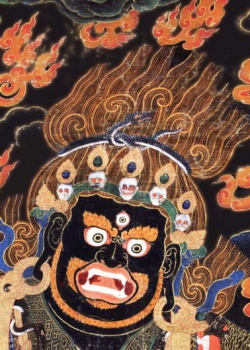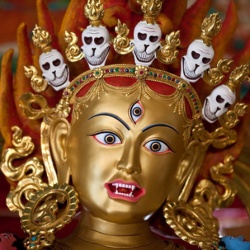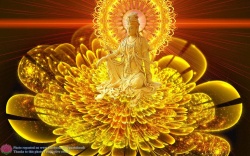Vajrayana: The Diamond Way
Vajrayana, the Diamond Way, is a group of teachings and practices taught by the “second Buddha”, the great tantric master from Oddiyana, Padmasambhava. He was known to the Tibetans as Guru Rinpoche, the precious teacher. At the invitation of the Tibetan king, Padmasambhava used his tantric magical powers to overcome the negative spiritual forces that were impeding the establishment of Buddhism in Tibet.
The Vajrayana introduced to Tibet and other Himalayan kingdoms is considered to be the supreme set of teachings and practices for several reasons. It has a vast wealth of practices, with techniques suited to a variety of individuals. It is not necessary to be a great ascetic practitioner to reach Enlightenment through Vajrayana practice. Nothing needs to be renounced; ascetic practice is counter-productive to one whose mind-set is suitable to Vajrayana. The practices of Hinayana, the Lesser Vehicle based on renunciation, may be recommended as a temporary technique to effect purification, but nothing needs to be given up except negative, harmful thoughts, speech and behavior.
Ascetic practices are characteristic of the Hinayana and are based on a desire to renounce, and thereby overcome, cyclic existence (Samsara). Hinayana is called Theravada, the Way of the Elders by its adherents, but this is historically incorrect. There were a total of eighteen schools of Buddhism comprising Hinayana and Theravada was only one of them.
Vajrayana also surpasses the Mahayana, or Great Vehicle practices. The Vajrayana practitioner, unlike the Bodhisattva, or awakening warrior of the Mahayana, has no need to transform anything. Renouncing nothing, transforming nothing, the Vajrayanist accepts everything (cho tam ches), just as it is (ji shin wa), as always already perfect (ye ne ka dak).
The Vajrayana is considered to be supreme for another reason: its techniques work more rapidly than those of the Hinayana or Mahayana. The Hinayana practitioner can achieve Enlightenment in three incalculable aeons. The practitioner of the Mahayana, the techniques of which develop the powerful awakening mind (chang chup gyi sem), can expect Enlightenment in as little as seven, or even three, lifetimes. But the practitioner of the powerful tantric techniques of Vajrayana can be enlightened in one body in a single lifetime.
Vajrayana was introduced to Tibet in two phases: the Old School Translations phase and the New Schools Translations phase. The Old School, the Nyingma Order of Tibetan Buddhism, was established mostly in the Eighth Century, by Padmasambhava, King Trison Detsen, Princess Yeshe Tsogyal, Padmasambhava’s consort, the translator Vairochana and others. The New Schools, the Kagyu, Sakya and Geluk, date from the Eleventh Century, when many scholars and translators went to India to procure new sources of transmission, as they felt that the original teachings had become corrupted.
The New Schools organized the Tantras into four categories: Preparation Tantra, Action Tantra, Union Tantra and Unsurpassed Union Tantra. In Preparation (Kriya) Tantra, you regard your chosen deity (Yidam) as a monarch, and yourself as its slave or serf. In Action (Charya) Tantra, you think of the deity as an eminent teacher, and yourself as a humble student. In Union (Naljor, Yoga) Tantra you perceive the deity as your friend and cultivate a relationship of equals. When practicing Unsurpassed Union (La.na.med.pai) Tantra, you become, or have always been, the deity. In each case, the divine form is considered to be essentially the same as your fundamental teacher, or root lama.
The Nyingma Order divided the totality of Buddha’s teachings into nine Yanas or vehicles. The Hinayana doctrines and meditations were divided into the vehicle of the pious listeners and that of the self-made Buddhas (Sravakas and Pratyeka Buddhas). Then came the great vehicle of the Bodhisattvas, based on the generation of awakening mind. The Tantras are divided into the three lower, or outer Tantras, Preparation, Action and Union, and the three higher, or inner Tantras, Maha, Anu and Ati. The Great Ati is synonymous with Dzogchen, or great completion yoga, the supreme and unsurpassed allembracing sphere of totality. The vehicles are distinguished one from the other on the basis of View, Meditation and Conduct.
Another way to describe Vajrayana is to speak of the Foundational practices (Ngondro), the Developing and Completion stages of Deity Yoga (Lha Kyerim dang Dzogrim), and the Main practices (Ngoshi), Great Middle Way, Great Symbol and Great Completion Yogas. The Foundational practices are performed 100,000 times each. They are: Going for Refuge, done in conjunction with the notorious 108,000 full prostrations; generating awakening mind; offering the Mandala of the entire universe; and Guru Yoga, in which the practitioner merges his or her limited, personal mind with the enlightened mind of the guru.
Developing Stage of Deity Yoga involves visualization of a divine form (Yidam), and recitation of an associated mantra. This is done within the context of your environment as a pure realm, your home, and all buildings, as heavenly mansions, and yourself and all other beings as gods and goddesses, either arisen from seed syllables (bija mantras), or always already divine. With sufficient experience of these practices, you see all form as divine form, hear all sound and noise as the chosen deity’s mantra, and accept all ideation to be the movement of enlightened mind.
In Completion Stage, the meditator remains in formless contemplation, secure in the appropriate view (Tawa), basically the view of Emptiness, which is also the heart of Great Vehicle teachings. The Main Practices reach the same end in different ways, like separate paths all leading to the same mountain peak. Madhyamaka, the great middle way, establishes the view of Emptiness through extremely subtle and profound philosophical analysis. Mahamudra, great symbol yoga, does the same thing by slowly unfolding direct experiences of enlightened states of consciousness. Great completion yoga, Dzogchen, accomplishes the same goal through instantaneous cognition, naked awareness (rigpa jenpa), of innate primordial purity (ye ne ka dak).
The supreme, most profound, most powerful and all encompassing, most easily and rapidly accomplished teachings and practices of Buddhism possess the qualities of the Vajra (dor.je, literally “noble stone”). A vajra is eternal and indestructible. Like a diamond it can cut anything, but nothing can cut it. It can penetrate anywhere but is itself impenetrable. Therefore it is said of it: E MA HO! Marvelous! How wonderful it is! Today the Vajrayana is practiced in Tibet, Japan, where the Shingon school flourishes, and it has been spread to virtually every country of the West, and to such places as Hong Kong and Malaysia, by the accomplished lamas of the Tibetan diaspora.


